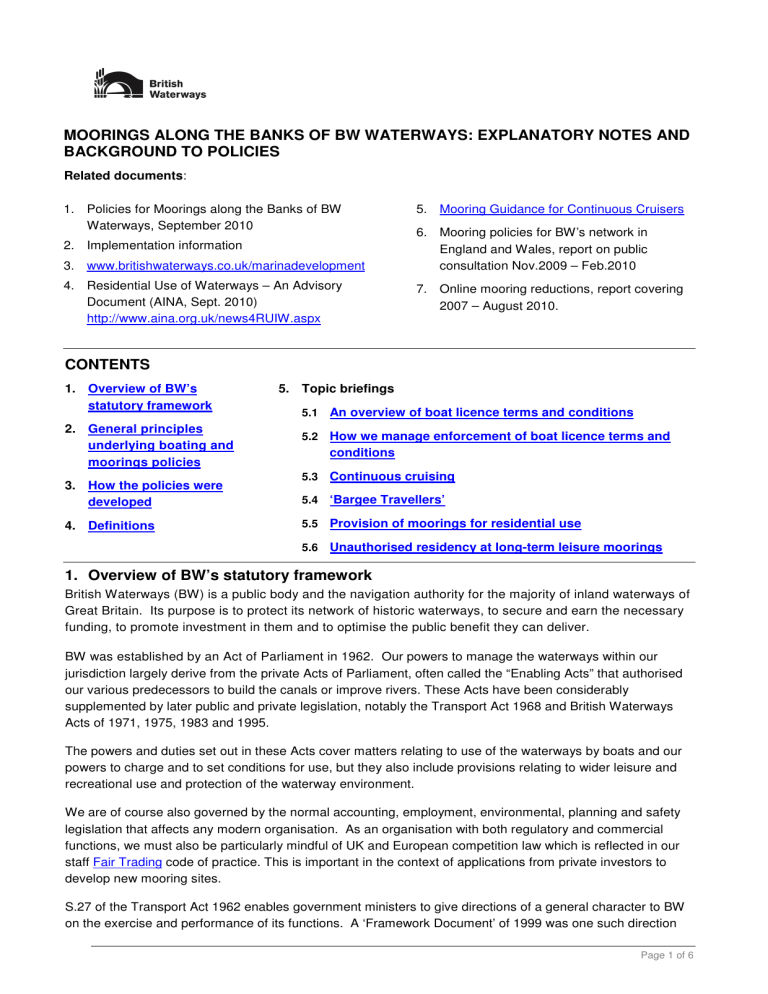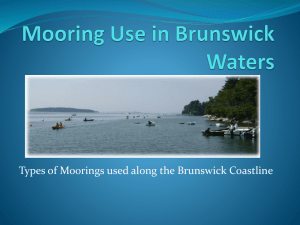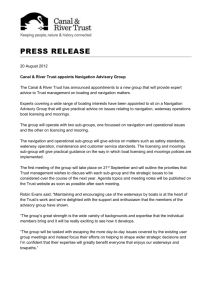Background and explanatory note on mooring

MOORINGS ALONG THE BANKS OF BW WATERWAYS: EXPLANATORY NOTES AND
BACKGROUND TO POLICIES
Related documents :
1. Policies for Moorings along the Banks of BW
Waterways, September 2010
2. Implementation information
3. www.britishwaterways.co.uk/marinadevelopment
4. Residential Use of Waterways – An Advisory
Document (AINA, Sept. 2010) http://www.aina.org.uk/news4RUIW.aspx
5. Mooring Guidance for Continuous Cruisers
6. Mooring policies for BW’s network in
England and Wales, report on public consultation Nov.2009 – Feb.2010
7. Online mooring reductions, report covering
2007 – August 2010.
CONTENTS
1. Overview of BW’s statutory framework
2. General principles underlying boating and moorings policies
3. How the policies were developed
4. Definitions
5. Topic briefings
5.1 An overview of boat licence terms and conditions
5.2 How we manage enforcement of boat licence terms and conditions
5.3 Continuous cruising
5.4 ‘Bargee Travellers’
5.5 Provision of moorings for residential use
5.6 Unauthorised residency at long-term leisure moorings
1. Overview of BW’s statutory framework
British Waterways (BW) is a public body and the navigation authority for the majority of inland waterways of
Great Britain. Its purpose is to protect its network of historic waterways, to secure and earn the necessary funding, to promote investment in them and to optimise the public benefit they can deliver.
BW was established by an Act of Parliament in 1962. Our powers to manage the waterways within our jurisdiction largely derive from the private Acts of Parliament, often called the “Enabling Acts” that authorised our various predecessors to build the canals or improve rivers. These Acts have been considerably supplemented by later public and private legislation, notably the Transport Act 1968 and British Waterways
Acts of 1971, 1975, 1983 and 1995.
The powers and duties set out in these Acts cover matters relating to use of the waterways by boats and our powers to charge and to set conditions for use, but they also include provisions relating to wider leisure and recreational use and protection of the waterway environment.
We are of course also governed by the normal accounting, employment, environmental, planning and safety legislation that affects any modern organisation. As an organisation with both regulatory and commercial functions, we must also be particularly mindful of UK and European competition law which is reflected in our staff Fair Trading code of practice. This is important in the context of applications from private investors to develop new mooring sites.
S.27 of the Transport Act 1962 enables government ministers to give directions of a general character to BW on the exercise and performance of its functions. A ‘Framework Document’ of 1999 was one such direction
Page 1 of 6
and this requires BW to operate commercially in order to generate income for the maintenance of the waterways. This applies to the provision of moorings, and note that we have no statutory powers or responsibilities for providing low cost moorings.
The British Waterways Act 1995 limits to three specific criteria our ability to refuse to licence a boat. These relate to (1) boat safety standards (the equivalent of the car MOT); (2) third party liability insurance cover; and
(3) the requirement for the boat to have a home mooring, unless it is used for navigation throughout the period of the licence. There are no statutory provisions for BW to refuse a licence on the grounds of say, congestion or aesthetics both of which are subjective. Adequate moorings control is therefore essential for preserving the amenity of the waterways for boating and other uses.
British Waterways boat licence terms and conditions, including navigation rules and mooring guidance are consistent with the relevant legislation and are the main basis for management actions in relation to boats on our waterways. We are able to revoke licences where people persistently breach terms and conditions..
Fees paid by boaters for licences and moorings provide a critical element of British Waterways funding. In
2009/10, for every £5 spent by BW on maintaining and repairing the waterways, approximately £1 was derived from this source.
2. General principles underlying boating and moorings policies
The following are principles that have evolved over a number of years and that influence management decisions within our boating and mooring business.
1. Boating is at the core of BW’s business. We want it to thrive into the future.
2. Navigation is what differentiates our canals and rivers from other water courses. We must have sufficient moorings but enough ‘breathing spaces’ between groups of moored boats to protect the intrinsic value of waterways as tranquil places for enjoyment.
3. Boating contributes to public amenity and local business prosperity. We want to foster a spirit of shared responsibility amongst local communities as well as amongst boaters for the development and fulfilment of waterways’ potential.
4. Continued growth in boat numbers must not be at the expense of the waterway environment and public amenity. Sustainable boating means conserving water when using locks, reducing waste, minimising disturbance and environmental impact and being considerate to other waterway users.
5. There should be a varied mix of moorings and facilities to meet demand from different segments of the boating market, and where there is competition between these groups for bank side space, we must have policies to encourage a fair and appropriate mix.
6. Healthy competition between providers of moorings and facilities encourages appropriate levels of provision and good choice for customers.
3. How the policies were developed
Three pieces of work fed into the set of policies published in September 2010.
1. In 2006 we set out our policies for long term moorings along the line of the waterways. This followed a period of challenge by the British Marine Federation who believed that BW was not sufficiently supportive of the development of new marinas by private investors. We reformed our internal processes to ensure that the granting of consent is given using consistent criteria and published helpful information on a dedicated website, www.britishwaterways.co.uk/marinadevelopment . This resulted in the creation of some 5,000 new offline long term mooring berths between 2006 and 2011. At the same time, we undertook to start reducing the number of authorised long term moorings along the line of the waterway in some areas and to tightly restrict the creation of new online moorings. This policy was published and became effective in January 2007, and the policy paper on this subject is still valid. See
Page 2 of 6
www.britishwaterways.co.uk/onlinemooringpol . The policy provisions are re-stated in Policies for
Moorings along the Banks of BW Waterways , published in September 2010.
2. Conscious of the serious shortage of authorised residential moorings (mooring sites which have local authority planning consent for use as a person’s primary residence), we undertook a programme of research and policy development in collaboration with the Residential Boat Owners Association during
2008 and 2009, and included the policy proposals within a wider public consultation on moorings policies,
November 2009 – February 2010. This consultation informed our September 2010 policy statement.
Our policy for residential moorings should be read in the context of the Association of Inland Navigation
Authorities’ Advisory Document on the Residential Use of Water. This informs local planning authorities, navigation authorities, mooring providers and residential boaters on residential boating matters.
3. The third piece of work has been the development of clearer policies for managing use of short term moorings along the towpath. This was a major theme within the November 2009 – February 2010 public consultation mentioned above. BW’s regular sample surveys of boat owners along with feedback from boaters, the boating trade and more recently, waterside residents and local authorities, pointed to growing concerns about the number of boats whose owners settle in a relatively small geographic area without a home mooring. The concerns usually relate to one of three themes: (1) impacts on the availability of short term moorings for cruising boaters: (2) perceived unfairness that such boaters contribute a great deal less to waterway upkeep than those who pay for a home mooring; (3) feedback from local communities that long term residential towpath moorers reduce the amenity of the waterway for other users and consume public services without paying council tax. We accept criticism levelled by many parties in the consultation that BW has failed to enforce licensing terms adequately in respect of these matters, and implementation of the mooring policies published in September 2010 will address this.
Policies for Moorings along the Banks of BW Waterways was informed by responses to the 2009/10 public consultation and subsequent discussions with representatives of national boating organisations.
4. Definitions
Casual mooring
This is the term used in BW’s statements of intent etc. made during the passage of the BW Act
1995 through parliament. It conveniently embraces both designated visitor moorings and towpaths generally where mooring is permitted for up to 14 days, unless otherwise indicated.
Visitor mooring
A length of bank that has been designated for temporary use for short periods only. Examples: designated visitor moorings, trip boat stop, moorings for use of sanitary station… Restrictions on use, including time limits should be clearly signed
A casual or a visitor mooring
Short-term mooring
Long-term mooring
Residential mooring
Also called a ‘ home mooring ’ in BW boat licence terms and conditions, where a boat is lawfully kept when not being used for cruising. It is the boat’s usual base or ‘parking space’. Examples: residential moorings, leisure moorings, trade moorings for commercial boats.…
Provided by private operators or BW
Sometimes referred to as ‘permanent mooring’
Usually let for periods of one year or more, and usually for a fee.
A long-term mooring which has planning permission and BW permission for the moored boat to be used as the occupant’s sole or primary residence.
The residential mooring may or may not have facilities and services.
A long-term mooring where the boat is used for leisure / recreational purposes.
Leisure mooring
Trade mooring
Moorings assigned to specially licensed operators of commercial boats. They may be for short periods or long term, depending on the nature of the agreement. Their purpose is to provide a service to waterway visitors, adding life and value to the local waterway environment.
Page 3 of 6
5. Topic briefings
1. An overview of boat licence terms and conditions
2. How we manage enforcement of boat licence terms and conditions
3. Continuous cruising
4. Relevance of Travellers legislation to waterways
5. Provision of moorings for residential use
6. Unauthorised residency at long-term leisure moorings
5.1 An overview of boat licence terms and conditions
Key provisions are under the following headings:
•
Use of the boat including mooring for short periods while cruising. ‘Short period’ means up to 14 days or less where a local restriction applies. Does not permit mooring for any longer period
•
Requirement to cruise continuously if the boat has no home mooring (see ‘continuous cruising’ below)
•
Boat safety and insurance requirements
•
Payment terms and requirement to display the licence, boat name and index number on both sides of the vessel
•
Compliance with navigation rules
•
Obligation not to cause damage or nuisance to any other person or their property
See http://www.britishwaterways.co.uk/license-it/licence-terms-and-conditions
5.2 How we manage enforcement of boat licence terms and conditions
We employ a national team of enforcement officers and support staff whose first responsibility is to monitor systematically the presence of boats on our waterways in order to ensure that they are correctly licensed.
This is done by regular foot patrols with the assistance of hand held computers. The index number of each boat observed is entered into the computer which then returns its licence status. An unlicensed boat will generate an action for the enforcement officer.
We have a series of standard advisory messages, warnings and then enforcement notices for boaters found to be either without a licence or in (suspected) breach of any of the terms and conditions. These are posted on the boat concerned in a ‘patrol notice’ envelope. Some of the letters are also posted to the licence holders last known home address(es).
After warning messages, the great majority of boaters respond positively and put the matter right. For the minority who persistently ignore the rules, we exercise the appropriate legal powers applicable to the problem in question. Depending on the circumstances, we may use our byelaw powers and prosecute in the
Magistrates Court. The sanctions would include a fine, legal costs and a criminal record, but the boat might still remain on the waterway without a licence. Our preferred route therefore in the case of unlicensed boats, particularly those being used for residential purposes, is to use civil remedies stemming from the licence agreement. This has the advantage of achieving a resolution in the form of a court order enabling us to remove the boat from the water.
We exercise our powers under Section 13 of the British Waterways Act 1971 or section 8 of the British
Waterways Act 1983 to remove a boat from the waterway. If the boat is a person’s sole residence, we will first obtain a Court Order before removing the boat.
Page 4 of 6
If a person is in breach of the licence terms and conditions, after due warning and allowance of reasonable time for them to put matters right, we will terminate the licence and exercise the above powers for removing it from the waterway. During the year to 31/3/2010, we issued over 2,000 initial patrol notice warnings and 100 section 8 or 13 notices and removed 70 boats
5.3 Continuous cruising
The British Waterways Act 1995 introduced a requirement that a vessel either (a) have a long term ‘home’ mooring, or (b) be used for navigation throughout the period of the licence. The key provision is
17(3) Notwithstanding anything in any enactment but subject to subsection (7) below, the Board may refuse a relevant consent in respect of any vessel unless—
(a) the applicant for the relevant consent satisfies the Board that the vessel complies with the standards applicable to that vessel;
(b) an insurance policy is in force in respect of the vessel and a copy of the policy, or evidence that it exists and is in force, has been produced to the Board; and
(c) either—
(i) the Board are satisfied that a mooring or other place where the vessel can reasonably be kept and may lawfully be left will be available for the vessel, whether on an inland waterway or elsewhere; or
(ii) the applicant for the relevant consent satisfies the Board that the vessel to which the application relates will be used bona fide for navigation throughout the period for which the consent is valid without remaining continuously in any one place for more than 14 days or such longer period as is reasonable in the circumstances.
The provision in c(i) above is commonly referred to as the ‘home mooring’ requirement and the provision in c(ii) above is commonly referred to as the ‘continuous cruising’ requirement.
The Act did not define ‘place’ but BW interprets this as a neighbourhood or locality, not a particular mooring site or position. Our reason for this interpretation is that we do not believe that the legislators would have gone to the lengths of requiring a ‘home mooring’ if they had intended such a wide scope for exceptions. The necessary movement from one neighbourhood to another can be done in one step or by short gradual steps.
What the law requires is that, if 14 days ago the boat was in neighbourhood X, by day 15 it must be in neighbourhood Y. Thereafter, the next movement must normally be to neighbourhood Z, and not back to neighbourhood X (with obvious exceptions such as reaching the end of a terminal waterway or reversing the direction of travel in the course of a genuine progressive journey).
What constitutes a 'neighbourhood' will vary from area to area – on a rural waterway a village or hamlet will be a neighbourhood and on an urban waterway a suburb or district within a town or city will be a neighbourhood.
A sensible and pragmatic judgement needs to be made.
It is not possible (nor appropriate) to specify distances that need to be travelled, since in densely populated areas different neighbourhoods will adjoin each other and in sparsely populated areas they may be far apart
(in which case uninhabited areas between neighbourhoods will in themselves usually be a locality or 'place').
Exact precision is not required or expected – what is required is that the boat is used for a genuine progressive journey (i.e. a cruise).
More precise definitions of neighbourhoods will be developed within the context of local mooring strategies as a means of helping boaters to determine local movement requirements.
5.4 ‘Bargee Travellers’
Local authorities have statutory duties relating to the provision of temporary stopping places for gypsies and travellers. These may extend to provision for certain ‘travelling boaters’. BW helps by providing casual moorings extensively throughout its network which are available to boat licence holders, subject to the terms and conditions of the licence. There are however no statutory requirements for any special provision for
‘travelling boaters’ and BW has no duties as a housing authority.
Page 5 of 6
5.5 Provision of moorings for residential use
The canals have always had a resident population, dating back to the first boatmen and their families living and working on the waterways. Clearly the context has changed over the years, but residential boating is a continuing feature of the waterway environment.
Whilst there are many different patterns and degrees of living afloat, our residential mooring policy relates to long-term moorings where the moored boat is used as someone’s sole or primary residence. The change of use of the Canal to a full time residential mooring may be a material change of use requiring planning permission.
There is very strong demand, which is growing, from people wanting to live afloat, and it is particularly high in certain locations close to population concentrations. Customer preferences for on site facilities range from demand for a comprehensive range of services to those who consciously seek out ‘low-impact living’ at sites with fewer facilities.
The supply of long-term mooring sites where residency is permitted (i.e. sites where planning permission has been granted for residential use by the Local Planning Authority (LPA)) is very limited (for example around 40 out of BW’s 400 long-term mooring sites are designated for residential use). They vary in the range of facilities provided and the location. Urban sites with good facilities are more common, although there are some sites in rural areas, and some have few facilities on site.
Waterways have a certain capacity for boating and different types of moorings (casual, long-term leisure and residential, plus trade). Some sections are nearing, or have reached, acceptable limits of mooring concentrations. However there are other areas that could comfortably accommodate more moorings. There is a need to achieve an appropriate level and mix of moorings on our network.
Despite significant differences between residential moorings and built development, there is no specific national planning policy or procedural guidance. Residential moorings are therefore treated by local planning authorities as residential development and subject to the relevant national and local planning policy. Much of our network is in areas where ‘bricks and mortar’ residential development is constrained or excluded.
BW does not have a responsibility to provide housing or affordable moorings. It provides residential moorings, for which it must charge market rates, as part of its commercial moorings business. Fees at residential sites tend to be higher than for leisure moorings, which reflect demand for a mooring where a boat can legitimately be used as a person’s main residence, and sometimes higher operational costs.
5.6 Unauthorised residency at long-term leisure moorings
A mooring for a boat used as someone’s sole or primary residence may require planning permission.
Therefore a boat occupied as a primary residence at a long-term leisure mooring would normally constitute (a) a breach of planning control and therefore (b) a breach of BW’s mooring agreement
1 or lease with an operator.
Where there is a breach of planning control, the Local Planning Authority (LPA) is not necessarily compelled to take action. They usually act if they believe it’s expedient to do so (e.g. the breach represents unacceptable development that cannot be properly controlled by conditions, is contrary to policy etc.) In other words they would have refused consent if a planning application had been submitted.
If BW knows there is unauthorised residential use, it means we are vulnerable to enforcement action. LPA’s expect BW, as navigation authority and land-owner of the waterway, to control and regulate activity at mooring sites. We are not however able to gather evidence of residential use, and it is up to the local authority to establish this.
1 Condition 8. You must comply with the conditions of any planning permission for the Mooring Site and comply with relevant laws, byelaws, Site Rules and special conditions, including any concerning your private use of land at the Mooring Site.
Page 6 of 6


